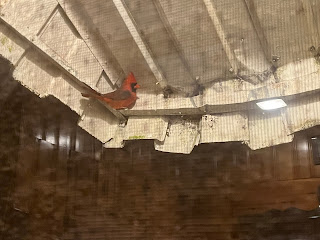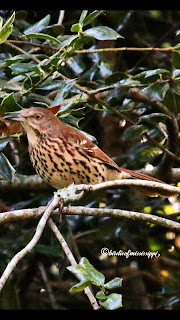BUT, BIRDIE IT'S COLD OUTSIDE
BUT, BIRDIE IT’S COLD OUTSIDE
By Peggy Williams AKA Birdie of Mississippi
Yes, it’s cold outside, but January and February are the months that
Birdies begin to look for sites to build their new spring nests to nurture baby
birds. It is also a good time for
Birders to go ahead and put out birdhouses for spring nesting. By putting
birdhouses out early, this will ensure that they would be available as
temporary shelter for birds should we have a cold snap, bad weather or as a
refuge from predators. Birds that have
more than one brood of birds nest early so that they can have time to do it
again later in the season. You will
begin to see them scouting your yard any time now to see if it would be a safe
place for their babies.
If you have bird houses already hanging, it would be good to clean out
any old nesting material that may still be there from last year and scrub the
house with one part bleach to nine parts water.
Rinse the house thoroughly and let it air dry. This will give the birds a fresh and clean
home to move into. Parasitic mites and
insects can move into abandoned nests so removal of nesting and cleaning will
help prevent this!
If you do not have existing birdhouses and plan to buy new ones here
are a few tips to keep in mind for attracting birds to your birdhouses. Birds - like humans have things that they are
looking for when they choose a new home.
Birds want their homes to be safe from bad weather and predators and it
must be large enough for the adult birds and their growing family. If you are looking to attract specific types
of birds such as bluebirds or purple martins there are birdhouses available
that are usually labeled for these birds.
If you plan to make your own birdhouses, then it would be good to check
out pre-built ones in the stores or online to get a general idea of the style
and size to make them. The entrance hole
is important to make certain that it is the right size for the bird that you
want to attract so that larger, aggressive birds or predators don’t take over the
house that you hang. I had never thought
of snakes getting into my birdhouses, but I have seen some photos of snakes
inside birdhouses that eat the eggs, chicks and adult birds! Many predators will scratch or gnaw on the
entrance holes to get inside, so you can install a metal plate which is a “hole
restrictor” over an existing entrance to prevent them from doing this!
The size of the roof is also important because some predators such as
raccoons, squirrels and even cats will actually sit on a roof and reach in to
get whatever is inside! An overhang on
the roof that extends 5 to 6 inches from the front of the house and 2 or 3
inches on the sides helps to keep predators from being able to reach
inside. A baffle above or below the
house or a large, smooth sheet of metal wrapped around the tree trunk or post
will also serve as a means of preventing predators from reaching inside the
birdhouse.
Do not have perches on the
birdhouse because it serves as a handhold for the predator as they raid the
nest! Hang your birdhouses 4 to 8 feet
from the ground for chickadees and titmice, 5-10 feet for bluebirds, wrens,
nuthatches and up to 15 feet for purple martins and away from buildings, trees,
fences or anything that the predator can spring from.
So bundle up and brave the cold if you want to make your feathery friends
come live in your yard. It is well worth
the effort as you see them flying about and hear them singing their cheery
songs in the early mornings of spring. So
“look at the birds of the air” (Matthew 6:26) and begin preparing homes for
them now.
My photos may be viewed & “LIKED”
on Facebook, Instagram and Pinterest - “Birdie of Mississippi”.




Comments
Post a Comment